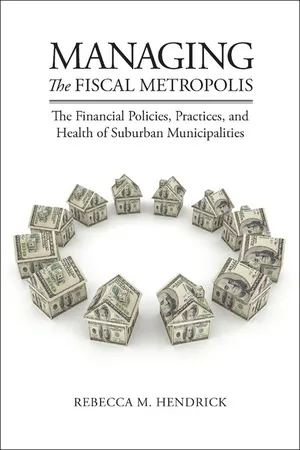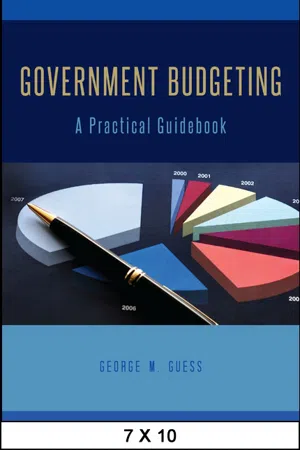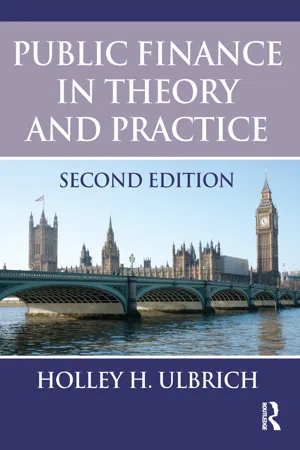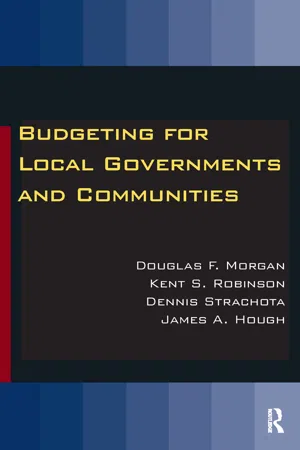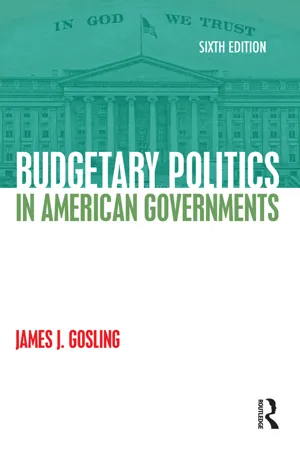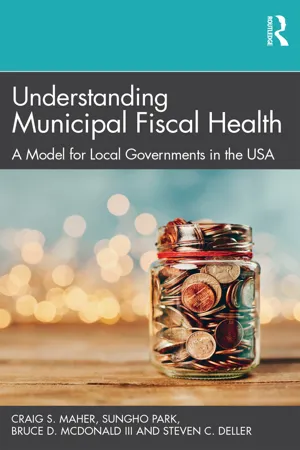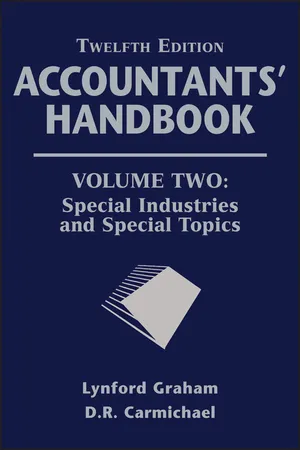Economics
Sources of Revenue for Local Government
Local governments generate revenue through various sources, including property taxes, sales taxes, income taxes, fees for services, grants, and intergovernmental transfers. Property taxes are a significant source of revenue, while sales taxes are often tied to local consumption. Income taxes may be levied on individuals or businesses, and fees for services can include charges for utilities, permits, and licenses.
Written by Perlego with AI-assistance
Related key terms
9 Key excerpts on "Sources of Revenue for Local Government"
- eBook - ePub
American Governance and Public Policy series
The Financial Policies, Practices, and Health of Suburban Municipalities
- Rebecca M. Hendrick(Author)
- 2011(Publication Date)
- Georgetown University Press(Publisher)
Own-source revenues are generated from resources within the local government’s jurisdiction, although they can be collected by other governments and distributed to the owner government at regular intervals. Local own-source revenues include property taxes, user fees, and other charges and in some states may include sales and income taxes. Local governments meet most of their service and financial obligations with own-source revenue, but much of their revenue can be intergovernmental in the form of general assistance from state government based on a formula or a share of state taxes and grants from state and federal government.A local government’s economic base represents the set of economic resources from which it draws own-source revenue. Its revenue base is that portion of the economic base it has access to through specific revenue-raising mechanisms as established by state statute and other legal and institutional constraints. Most local governments have access to property values (property tax), and some have access to sales receipts (sales taxes), resident and nonresident income (payroll tax), and other sectors of the economy (e.g., utility usage and development). Income per capita is also considered to be a good measure of total revenue base wealth in governments with few revenues generated from businesses or nonresidents (Berne and Schramm 1986). The value of many specific revenue bases also are greatly affected by population growth and economic development, which, over time, may increase property values and the revenue generated from fees (e.g., building permits).Own-source revenue capacity reflects that portion of the revenue base the government can collect, which also is established in most cases by state statute. For instance, state governments often limit the maximum property tax rates local governments can levy. Thus a local government’s revenue-raising capacity for a particular type of revenue is the maximum level of revenue it could raise from that source. Actual revenues are the amount of revenues it actually collects and revenue reserves - eBook - ePub
The Fiscal Impact Handbook
Estimating Local Costs and Revenues of Land Development
- David Listokin(Author)
- 2017(Publication Date)
- Routledge(Publisher)
This chapter has pointed out the relative importance and geographic concentration of components of local sources of revenue. The fiscal impact analyst must be aware of which sources of revenue are emphasized in the locale where he is working so he can properly project local resources. He must also be aware of the general nature of revenue systems used elsewhere so he can correctly interpret the results of fiscal impact analyses undertaken at several locations. For example, a housing development may have a favorable local cost-revenue impact in an essentially residential area which depends heavily on the real property tax for local revenues. Its impact may be unfavorable, however, in a locality which relies upon a state-levied sales tax for local revenues.EXHIBIT 8-16 RANK ORDER OF STATES IN USING CHARGES AND MISCELLANEOUS REVENUES TO SUPPORT MUNICIPAL OPERATIONS (1972)EXHIBIT 8-17 RANK ORDER OF STATES IN USING CHARGES AND MISCELLANEOUS REVENUES TO SUPPORT SCHOOL DISTRICT OPERATIONS (1972)Exhibits 8-18 , 8-19 , and 8-20 summarize the information presented thus far. Exhibit 8-18 clearly shows that school districts and municipalities fund expenditures differently. School districts rely heavily on intergovernmental transfers (for about 45 percent of total revenues), and 96 percent of that source comes from the state. Municipalities, on the other hand, rely much less on intergovernmental transfers, and a smaller share (80 percent) of these revenues comes directly from the state.Municipalities and school districts differ significantly in their dependence on various categories of own source revenue. School districts depend more heavily on property tax revenues to finance expenditures, but municipalities emphasize sales, income, and other taxes; user charges; and miscellaneous revenue.Exhibit 8-19 - eBook - ePub
Government Budgeting
A Practical Guidebook
- George M. Guess(Author)
- 2015(Publication Date)
- SUNY Press(Publisher)
Despite these real constraints and the fact that global forecasts depend on aggregation of sub-forecasts for each source, revenue budgets have been historically conservative and quite accurate. That changed in 2007, when it was clear that the baselines and forecasts did not include a recession (Francis, 2012, p. 501). Even in 2008, the recession was predicted to be narrow because it was restricted to housing markets. With hindsight it is clear that housing market exposure was not given proper weight (2012, p. 504). But even those data might not have changed revenue forecasting models since rating agencies had missed the extent of toxic mortgages that had been packaged, securitized, and sold as investment-grade debt. Since bond insurers relied on the same ratings that overlooked subprime mortgage debt, the subsequent collapse resulted in downgrades of municipal debt and higher borrowing costs for cities already strapped by loss of revenues from the recession (Petersen & Ciccarone, 2012, p. 691).The revenue budget consists of estimates for tax, fee, and intergovernmental transfer or aid sources. In volatile economic times, the level of state or county aid will be affected by politics and institutional rules, which may throw off the total estimate of yields. The more a jurisdiction relies on a volatile income source, the greater its effect on the public finances. For example, since it has no income tax (which is usually more stable), the State of Texas relies heavily on sales tax receipts, which fluctuate widely with economic conditions. The state recently discovered that it had underestimated revenues in 2011 by about 28 percent. By law, the comptroller’s revenue estimate ($72.4b forecast versus $101.4b actual) governs expenditure for the next two fiscal years. Texas is one of seven states to still have biennial legislative sessions and a two-year budget based on their decisions (Economist, 2013a). Such uncontrollable variables are a fact of life for budget practitioners, and perhaps the best way to deal with such uncertainty is to maintain open lines of communication with council and legislative liaisons. Such contacts can reduce surprise revenue fluctuations that diminish the accuracy of the planned budget, which leads to service and program disruptions during execution. To allow for course corrections in volatile economic times, revenues may have to be estimated on a rolling basis. It not unusual for cities to experience sudden losses from revenues that did not materialize from higher-tier grants or riders that did not patronize subsidized services such as transit.Property Tax and AssessmentThe property tax is still the most important revenue source for local governments. It provided 45 percent of local own-source revenues and 72 percent of local taxes in 2008 (down from 56 percent and 86 percent respectively in 1968) (Bell, 2012, p. 271). It is flexible and can be used to target growth. Despite weakening of this critical own-source of revenues by antitax legislation from property owners, for instance, California’s Proposition 13, the tax still raised 73.9 percent of total local government revenue and 33.3percent of state and local revenue in 2009 (Mikesell, 2014, p. 488). Wisconsin state law, for instance, prevents localities from raising significant revenues from any other source but the property tax (Milwaukee Plan and Budget - Holley Ulbrich(Author)
- 2013(Publication Date)
- Routledge(Publisher)
Part 3 Funding Government Taxes, Fees, and GrantsThe next seven chapters address the revenue side of government: the funds to pay for public programs, the distribution of the burden of paying for government, and the use of revenue instruments as means toward specific policy ends. The primary revenue source for government is taxes. Taxes are the focus of the next five chapters.The first two chapters explore the theory and practice of tax system design. The next three discuss each of the broad categories of taxes—income, sales, and property. The final two chapters in this part examine two other important revenue sources, fees and charges and intergovernmental grants.According to Justice Oliver Wendell Holmes, taxes are the price we pay for a civilized society. That dictum still leaves room to argue over whether the taxes are too high relative to the amount of civilization that citizens want or need or actually receive in return. It does mean that taxes are an inevitable part of living in society. Given the necessity of taxes, it is the economist’s task to provide some guidance in designing a tax system that minimizes the undesired side-effects of collecting them (efficiency) and apportions the burden in some way that addresses the equity concerns raised in Chapter 5 .Although taxes are still the primary form of revenue for governments at all levels, they are not the only source. Fees and charges, discussed in Chapter 16 , are a second and increasingly important way of paying for services that have some advantages in terms of both efficiency and equity. In both unitary and federal systems, intergovernmental grants represent an important supplement to own-source revenues for lower levels of government, a subject addressed in Chapter 17- eBook - ePub
- Douglas Morgan, Kent S. Robinson, Dennis Strachota, James A. Hough(Authors)
- 2017(Publication Date)
- Routledge(Publisher)
Intergovernmental revenues reflect the principles of federalism and local autonomy that are built into the U.S. and state constitutions. Governments at any level—federal, state, or local—may independently raise revenues and may, within their authority, transfer or grant revenues to other levels of government to further the public good. From a budgeting perspective, revenues transferred from one governmental entity to another governmental entity on the same or on a different level are categorized as intergovernmental revenues. Intergovernmental revenues are roughly structured in the following forms:- Direct grants or payments for the performance of a specific service or defined program of services under a voluntary intergovernmental agreement or a contract.
- Reimbursement payments to another level of government to offset the costs of providing statutorily delegated or mandated programs and services, allocated by formula, lump sum, or entitlement.
- Revenue sharing between one level of government and another.3
State governments are the largest source of intergovernmental revenues for local governments. These revenues range from the direct return of shared tax collections to reimbursements granted for the operation of specific programs or services. Federal transfers typically provide an important but smaller source of intergovernmental revenues for cities, towns, and special districts. Federal funds often become the final source of several complementary revenues for a project, thus making it achievable. Local governments must carefully document intergovernmental revenues both for legal and financial compliance purposes, and to enhance transparency and public trust.Direct Grants and Payments
Direct grants and payments for services are voluntary exchanges between governments. These types of grants and payments often exchange the performance of services for payment. For example, a small city might purchase law enforcement services from the local county sheriff’s department. The purchase would be structured under an intergovernmental agreement, similar to a contract that would specify the services provided, staffing and performance criteria, and payment amounts and schedules. The city would make regular payments, and the county sheriff’s office would register those payments as intergovernmental revenues. Programs to make intergovernmental grants may be structured on a competitive or noncompetitive basis, but the final decision to enter into agreement is voluntary. Federal grants in this category would typically include project grants, cooperative agreements, and direct federal payments for a specific use of local services (CFDA 2011 - eBook - ePub
- James J. Gosling(Author)
- 2015(Publication Date)
- Routledge(Publisher)
Despite these incentives for local budget makers to build an acceptable surplus into the budget, economic recessions have diminished or eliminated surpluses, with the greatest impact felt during the Great Recession of 2007–9. The major fiscal choices facing local politicians overall have been not how to use surpluses but how to find adequate revenues to continue present service levels while expenditures grow faster than revenues. State legislatures have also enacted laws that placed limits on local tax and expenditure increases. Where legislatures failed to act, citizens in several states took matters into their own hands, passing initiatives and popular referenda that set local tax and spending limits. To make matters worse for local policy makers, cuts in federal aid reduced revenues that had been used to supplement local funds. In addition, the states, for the most part, have chosen not to increase local aid sufficiently to fill the gap. The resulting challenge for local policy makers has been to find new revenues amid revenue-raising constraints while seeking to keep expenditure increases within the limits of revenue availability.Although local units of government across the nation share common elements of the characteristic problem of local government finance, some have worse problems than others. Jurisdictions that have lost their tax base—as a result of lost employment and declining population—face greater pressures on the revenue side than those that have grown. Nationally, cities experience employment and population decline more than suburbs do. As productive people and jobs move from cities to suburbs, so do economic resources. The extent of that economic impact can be approximated by focusing on per capita income as a measure of the economic health of a community and as an indicator of its potential tax base. As reported by the U.S. House of Representatives’ Ways and Means Committee, central cities had 15 percent of their residents living in poverty in 1978; by 1998, that percentage had risen to 19 percent, and it remained there in 2013.1In contrast, growing jurisdictions have not only enjoyed expanding tax bases but also faced rising demands for the extension and expansion of government services. Their fiscal prospects are brighter, in comparison, because they can use the expanded revenue base to finance the growing services. Declining jurisdictions find it difficult to reduce service costs in proportion to reductions in population and employment. They are left with fixed overhead costs—most of them in personnel—that support declining levels of service. Accordingly, declining jurisdictions are more likely to see program expenditures rise faster per capita than are expanding jurisdictions, especially in the economically sensitive program areas of social welfare, public health, and community development. At the same time, governments in decline face the need to replace revenues forgone by a diminished tax base; but the very reality of tax base decline makes raising the needed revenues more difficult. Tax increases reduce the prospects of attracting economic development and the jobs that come with it, by creating a disincentive to growth that further exacerbates the problem. - eBook - ePub
Understanding Municipal Fiscal Health
A Model for Local Governments in the USA
- Craig S. Maher, Sungho Park, Bruce D. McDonald III, Steven C. Deller(Authors)
- 2023(Publication Date)
- Routledge(Publisher)
Note: All fiscal information is adjusted for inflation (base year: 2017); each source’s percentage share of total general revenues in parenthesisTable 3.6 Municipal General Revenue Sources: Charges and Others (Real per Capita)1972 1977 1982 1987 1992 1997 2002 2007 2012 2017 Total general revenues 16.6 42.7 117.8 186.1 324.1 481.5 645.0 957.9 1,155.6 1,509.4 Total charges 1.1(6.6) 3.8(8.9) 17.5(14.9) 29.6(15.9) 62.8(19.4) 97.9(20.3) 133.9(20.8) 197.1(20.6) 264.9(22.9) 340.8(22.6) Sewerage 0.4(2.4) 1.0(2.3) 4.1(3.5) 11.5(6.2) 27.0(8.3) 41.4(8.6) 61.6(9.6) 92.1(9.6) 126.3(10.9) 155.8(10.3) Solid waste 0.1(0.6) 0.3(0.7) 1.3(1.1) 3.2(1.7) 7.7(2.4) 13.9(2.9) 20.3(3.1) 28.1(2.9) 38.1(3.3) 43.1(2.9) Hospitals 0.3(1.8) 0.7(1.6) 4.4(3.7) 4.4(2.4) 8.5(2.6) 10.3(2.1) 12.0(1.9) 19.6(2.0) 28.1(2.4) 38.9(2.6) Parks and recreation 0.06(0.4) 0.1(0.2) 0.5(0.4) 1.3(0.7) 2.3(0.7) 4.0(0.8) 6.3(1.0) 9.8(1.0) 15.5(1.3) 19.4(1.3) Air transport 0.02(0.1) 0.04(0.1) 0.2(0.2) 0.3(0.2) 0.5(0.2) 0.7(0.1) 0.9(0.1) 1.6(0.2) 2.3(0.2) 2.4(0.2) Housing and community 0.009(0.1) 0.02(0.0) 0.06(0.1) 0.2(0.1) 0.4(0.1) 1.1(0.2) 1.0(0.2) 1.9(0.2) 3.2(0.3) 3.6(0.2) Others 0.2(1.2) 1.6(3.7) 6.9(5.9) 8.7(4.7) 16.4(5.1) 26.5(5.5) 31.8(4.9) 44.0(4.6) 51.4(4.4) 77.6(5.1) Other own source revenues 4.0(24.1) 5.9(13.8) 20.4(17.3) 34.5(18.5) 48.6(15.0) 66.3(13.8) 82.2(12.7) 113.2(11.8) 101.0(8.7) 134.9(8.9) Source: U.S. Census BureauNote: All fiscal information is adjusted for inflation (base year: 2017); each source’s percentage share of total general revenues in parenthesisThis trend is often described as revenue diversification, which primarily means that government revenue structures have shifted away from the traditional and most salient tax sources toward non-traditional revenue sources (Oates, 1991 ; Wagner, 1976 ). Historically, the tax revolt movement in the 1970s and 1980s and economic recessions, during which municipal governments experienced severe revenue constraints and hence were motivated to find new revenue sources, have been crucial moments for revenue diversification (Carroll, 2009 ; Hendrick, 2002 - D. R. Carmichael, Lynford Graham(Authors)
- 2012(Publication Date)
- Wiley(Publisher)
The specific procedures involved in the preparation of a budget for a governmental unit are usually prescribed by state statute, local charter, or ordinance. There are, however, certain basic steps:- Prepare the budget calendar.
- Develop preliminary forecasts of available revenues, recurring expenditures, and new programs.
- Formulate and promulgate a statement of executive budget policy to the operating departments.
- Prepare and distribute budget instructions, budget forms, and related information.
- Review departmental budget requests and supporting work sheets.
- Interview department heads for the purpose of adjusting or approving their requests in a tentative budget.
- Assemble the final tentative budget, including fixing of revenue estimates and the required tax levy.
- Present the tentative budget to the legislative body and the public.
- Conduct a public hearing, with advance legal notice.
- Legislative body adopts final budget.
Revenue and Expenditure Estimates
The property tax has been the traditional basic source of revenue for local government. The amount to be budgeted and raised is determined by subtracting the estimated nonproperty taxes and other revenues, plus the reappropriated fund balance, from budgeted expenditures. This amount, divided by the assessed valuation of taxable property within the boundaries of the governmental unit, produces the required tax rate.Many jurisdictions have legal ceilings on the property tax rates available for general operating purposes. Additionally, taxpayer initiatives have forced governments to seek new revenue sources. Accordingly, governmental units have turned increasingly to other types of revenue, such as sales taxes; business and nonbusiness license fees; charges for services; state-collected, locally shared taxes; and grants-in-aid from the federal and state governments. Department heads, however, ordinarily have little knowledge of revenue figures. As a result, the primary responsibility for estimating these revenues usually lies with the budget officer and the chief finance officer.- eBook - ePub
The People's Money
Pensions, Debt, and Government Services
- Michael A. Pagano, Michael A. Pagano(Authors)
- 2019(Publication Date)
- University of Illinois Press(Publisher)
38 . Enterprise charges are for water, sewer, transit, gas, electric, and hospitals. Airports and water ports are other enterprises that should be removed here, but the sources of data used to construct these tables do not show charges for these enterprises separately. In other studies, general revenue excludes charges for water, transit, gas, and electric but includes other enterprises. Total revenue includes charges for all enterprises, and own-source revenue excludes intergovernmental aid.39 . Rebecca Hendrick, “In the Shadow of State Government: Changes in Municipal Spending after Two Recessions,” working paper under review (2018).40 . Hendrick, “In the Shadow of State Government.”41 . Kim, “Limits of Property Taxes and Charges.”42 . Hendrick, “In the Shadow of State Government”; Richard F. Dye and Andrew Reschovsky, “Property Tax Responses to State Aid Cuts in the Recent Fiscal Crisis,” Public Budgeting and Finance 28, no. 2 (2008): 87-111; Erich Cromwell and Keith Ihlanfedt, “Local Government Response to Exogenous Shocks in Revenue Sources: Evidence from Florida,” National Tax Journal 68, no. 2 (2015): 339-76.43 . Kimberly L. Nelson, “Municipal Choices during a Recession: Bounded Rationality and Innovation,” State and Local Government Review 44, no. 1S (2012): 44–63.44 . The effects of recessions on local governments lag for at least one year after the recession starts.45 . Vehicle license fees are included in highway charges because many governments earmark these licenses for roads and transportation.46 . Rebecca Hendrick and Shu Wang, “Use of Special Assessments by Municipal Governments in the Chicago Metropolitan Area: Is Leviathan Tamed?,” Public Budgeting and Finance (2017), https://doi-org.proxy.cc.uic.edu/10.1111/pbaf.12190 .47 . Bird and Tsiopoulos, “User Charges for Public Services,” 51.48 . Bird and Tsiopoulos, “User Charges for Public Services.”49 . Duff, “Benefit Taxes and User Fees.”50 . Bird and Tsiopoulos, “User Charges for Public Services.”51 . Michael E. D. Koenig and Johanna Goforth, “Libraries and the Cost Recovery Imperative: The Emergence of the Issue,” IFLA Journal
Index pages curate the most relevant extracts from our library of academic textbooks. They’ve been created using an in-house natural language model (NLM), each adding context and meaning to key research topics.
